#travel essays
Photo

It’s the way I thought my restless wandering was over, that I’d found whatever I thought I had found, or wanted, or needed, and I started to collect my belongings. Build a home. Safe behind the comfort of these four walls and a closed door.
Because as much as I tried or pretended or imagined myself as a part of all the people out there,
I was still the one locking the door every night.
Turning off the phone and blowing out the candles so no one knew I was home.
’cause I was never really well around the expectations of my personality
and I wanted to keep to myself.
and because I haven’t been very impressed lately.
By people,
or places.
Or the way someone said he loved me and then slowly changed his mind.
// from my book of travel diaries Another Vagabond Lost To Love ☾ Download a free digital version of the book here ♡
#my writings#free books#free ebooks#poetry books#wandering#travel#travel writings#travel essays#quotes#quote#lit#charlotte eriksson
68 notes
·
View notes
Text
Still Wish You Were Here
Since I turned in the final changes on 222 Cemeteries to See Before You Die in November, I’ve been working on finishing another cemetery memoir. Like Wish You Were Here before it, this book will collect a bunch of my previously published cemetery travel essays. I’m also writing a whole bunch more new pieces for the book.
Still Wish You Were Here covers more time than the first book: three and a…
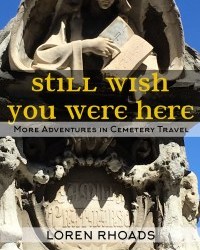
View On WordPress
0 notes
Text
Tired Ghost
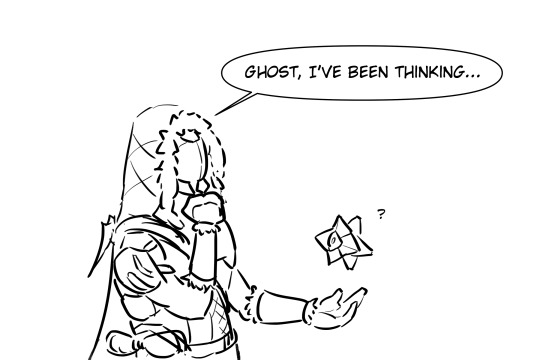
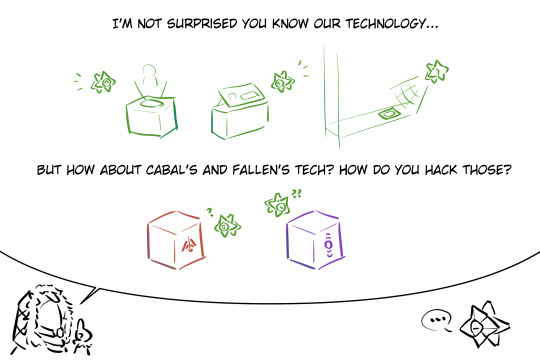
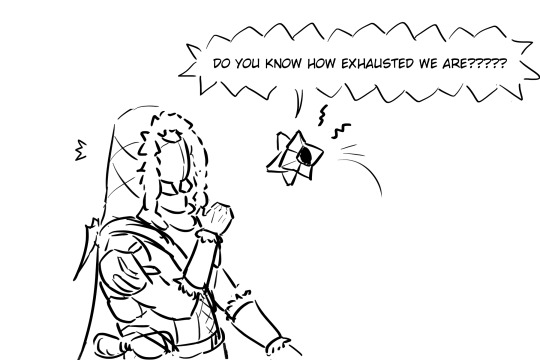


#i don't wanna spend too much time on this#(wrote an essay about how i thought vanguard hacking kit was developed)#yep that's not lorem ipsum#i just wanna see ghost complaining don't judge me too much#i didn't take history class in the ishtar collective (TM) those are all ooc don't actually read into that#if you actually know what im saying then you'd know i probably failed my computer security lesson#also the traveller probably gave them similar tech so their physical architecture should be similar#also ur a nerd lol#destiny 2#destiny hunter#destiny ghost#destiny 2 art#my art
670 notes
·
View notes
Text
thinking about time lords and their fucked up little society again and i just realized how devastating the revelation of the drums in the end of time is in relation to the master's character.
because of all the renegade time lords in the universe, i think it's the master who most exemplifies the philosophical outlook that the time lords have towards the rest of the universe. they're stuffy observers, administrators, yes - but this position is one they've decided for themselves because of this concept of supremacy over other life forms. imposed and upheld this idea that other species that lack a time sense are less-than, primitive. and the master buys into this hard.
and i mean... compared to the doctor, the master is good at being a time lord. he buys into these supremacist concepts, this idea that every other species (and especially humans) is practically a meaningless ant in the grand scheme of the universe. takes it to the extreme, yes, but its the same underlying principle. he's a good student (despite whatever chibnall might think) - that one time lord from terror of the autons (identity forever a mystery) (its brax) even says "he did receive a higher degree of cosmic science than you." the master could play their game if he wanted to. he's remarkably comfortable with being on gallifrey/the idea of gallifrey(in eot/tlotl) than the doctor ever is. where the doctor avoids the subject of the lord presidency like the plague, the master is like "well if you kill the president you ARE the president! and then you have all of gallifrey!" and when the doctor destroys gallifrey (nominally), the master tries to rebuild it in the sound of drums/last of the time lords. tries to emulate their society. honor them in his little fucked up way. he brings them back from the time war!
and what does he get for it? how did the time lords treat him in response?
they decide to implant the sound of drums in his head, stretching back until he's a child. puts this insufferable noise, this splitting headache, in his head for his entire life. all so that they may live while he dies. because he is diseased, because of them. he has swallowed the pill, bought their propaganda, he has followed the rules, he tried to rebuild them he tried. and in response he is chewed up and spit out like trash so that rassilon's god complex can survive while the universe crumbles.
how crushing must that be to someone? to have your whole worldview - that you are better, you are chosen, you are special - come crumbling down in a few short moments? to see the revered founder-god of the civilization you have so desperately tried to revive look at you and say "you are diseased," even though he was the one to poison you in the first place?
and as his heart is torn to pieces... when rassilon says "no more," and charges his gauntlet, the master - who has spent countless lives fighting death with his bare hands - does not move.
part of me thinks he does not want to.
#and this is why i think if the master didn't get vacuumed into the time war in eot he would have had a mid-mid-mid-life crisis#and then probably just traveled with the doctor to do some gay soul searching#you gotta hold on to something when your entire worldview just got smashed to pieces. might as well be your sad wet cat of a boyfriend#he burns down a small village one day and ten is like finally... nature is healing...#i have an essay due uhhh negative a week ago but this thought grabbed my brain and would not let go#simm!master#the master#doctor who#dw#time lords#tensimm#<- mentioned in tags#may be lowkey incomprehensible i wrote this at one am
914 notes
·
View notes
Text
come watch my new video essay...
youtube
it's about the 2018 german time travel murder mystery show DARK and the limitations of the streaming model of television
it premieres in an hour. you should be there.
154 notes
·
View notes
Text
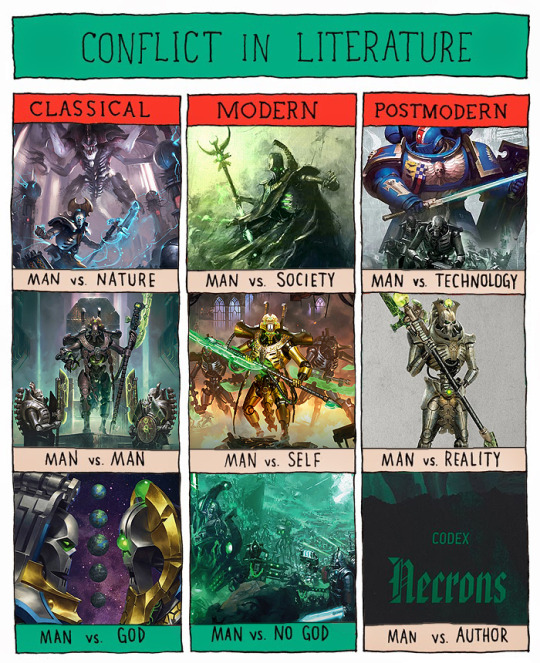
Conflict in Literature + Necron Books
(Read more for titles and notes, watch out for spoilers)
Man vs. Nature - Devourer
This is not the only necron vs. tyranid lit, but I thought the cover illustrated the conflict best. Out of all the horribad things in WH40K, the tyranids tend to be presented as the closest faction to a natural disaster; certainly in Devourer they do not logically justify their presence, nor can they be reasoned with, not by the Blood Angels or Anrakyr or the Tomb World he's trying to wake. Not mindless, but an amoral happenstance, like nature itself.
Man vs. Society - The Lords of Borsis
Necron court intrigue played straight, with a sprinkle of delusion on the side. Since this story revolves entirely around the schemings and plottings of necron(tyr) society, with changes in dynastic hierarchy as the final objective, it fits best here.
Man vs. Technology - Indomitus
This is an awkward placement, since Indomitus was not, well... a compelling story, with most of its tropes not being explored beyond their first introduction. But it is the most bare-bones way of describing this book's premise. Humans battling a robotic malignancy, albeit with a Bolivian Army Ending, which doesn't conclude the plot in either direction 😞
Man vs. Man - The Twice-Dead King: Ruin
Ruin is an exceptionally deep novel, and fits every conflict listed here. It was the hardest one to place, because it's not so much choosing the one that goes best, rather crossing off every other conflict not central to the story. Both gods and the absence-of-gods are a problem in Ruin, as well as nature and technology, but they're not at the heart of Oltyx's problem. Society could be a big one, since Oltyx is an exile - but he’s not trying to antagonize his society throughout Ruin, he's trying to work with it, or at least save it from doom. Self and reality both count, but fit better with other stories in the Nate Crowley corpus. So man vs. man it is. His most important clashes are all with individuals ('man') - Djoseras, Unnas, Hemiun, arguably Yenekh in reserve - and by the end, his crownworld is overrun by the Imperium, who will become the antagonists for the second part of his tale. Man vs. 'Man', with a capital M.
Man vs. Self - The Twice-Dead King: Reign
Again, this could have gone elsewhere. In man vs. reality, perhaps, or the god-related ones. But the self is where the conflict of Reign truly lies, since Oltyx's greatest obstacle is himself, and it is his inability to accept that which brings his dynasty close to destruction. Thank goodness he got over that one.
Man vs. Reality - Severed
The emotional and philosophical core of this novella relies on it. Zahndrekh's inability to see the world as it is brings about the whole plot, and is at the centre of all of Obyron's musings. Interestingly, reality does not win at the end, at least not what necrons envision reality to be: a place of cold hard facts, with no room for emotion. Zahndrekh would rather dream the impossible dream, which might be the healthier way to deal with their situation.
Man vs. God - The Infinite and the Divine
🚨 𝔻𝕆 ℕ𝕆𝕋 𝔹𝔼 𝔻𝔼ℂ𝔼𝕀𝕍𝔼𝔻 🚨
Man vs. No God - Crusade: Pariah Nexus
Not a novel, not 100% about necrons, not even out yet as of now (Dec 2023). This is an inherently problematic conflict for WH40K, because gods are very real and very present in that universe... here I'm only thinking about the necron perspective, and the civil war unfolding in their lore. They banded together in a shared purpose eons ago, destroying the Old Ones who oppressed them, and sundering the star gods who subjected them to biotransference. Now they are as antigod as they could be, and they did not retain their bonds, they have once again turned on each other. So it goes.
Man vs. Author - Codex: Necrons (10th Ed.) (Collector's Ed.)
James Workshop knows what they did. 😑
#warhammer 40k#wh40k#trazyn the infinite#orikan the diviner#the infinite and the divine#essay#oltyx#the twice dead king#anrakyr the traveller#devourer#the lords of borsis#indomitus#nemesor zahndrekh#vargard obyron#severed#pariah nexus#codex: necrons#necron#necrons#conflict in literature
285 notes
·
View notes
Text

there is so much stubborn hope in the human heart.
// albert camus, the myth of sisyphus and other essays
#photography#ph#venice#venezia#italy#travel photography#italia#art#q#quote#albert camus#hope#the myth of sisyphus and other essays#words#writing#europe#real life#travel#photo#poetry#artist#nature#beauty#architecture#view
183 notes
·
View notes
Link
I slept under the overpass that night, and in the morning, I wrote a review: “Reasonably good bridge. A little loud for sleeping.” I gave it four stars. After I set off on my bike, I couldn’t stop thinking about it. Because of Google Reviews — because multiple people took the time to review this squat bridge in the middle of nowhere — I felt like I was part of some shared human experience, the newest member of an obscure club. Maybe the other reviewers would disagree, but this moment felt powerful, like seeing other people’s names etched into a park bench or finding yourself deeply moved by the graffiti inside a public bathroom stall. But it was also weird: This tool for consumer reviews had become a digital guestbook for anything and everything in the world.
After that experience at Puente Las Bramonas, I started looking for reviews everywhere. Three stars for an 18th-century governor’s mansion in New Jersey (“very clean old and haunted,” Brianna Baker wrote). Two stars for a shop selling natural handcrafted products in Prince Edward Island (apparently they sell too much tea tree oil, which is toxic to dogs). Four stars for the Environmental Protection Agency office in Chicago (“great time,” writes Ryan Shippen). Hospitals and government agencies are frequent targets, with Google Reviews serving as a form of protest against frustrating systems far bigger than ourselves. On the outskirts of Chicago, unhappy truckers have dragged the rating for a railyard dock down to 2.7 stars, giving insight into an unhappy drama of delayed and misplaced shipping containers and exasperated big rig operators.
The overwhelming crush of reviews — everything rated, every opinion commodified and digitized, every small subplot in life available for critique — borders on farcical.
What happens when you can rate the world around you on a five-star scale? We’re ringing in the new year with Will McCarthy’s wonderful essay on the strange, communal experience of Google Reviews.
1K notes
·
View notes
Text
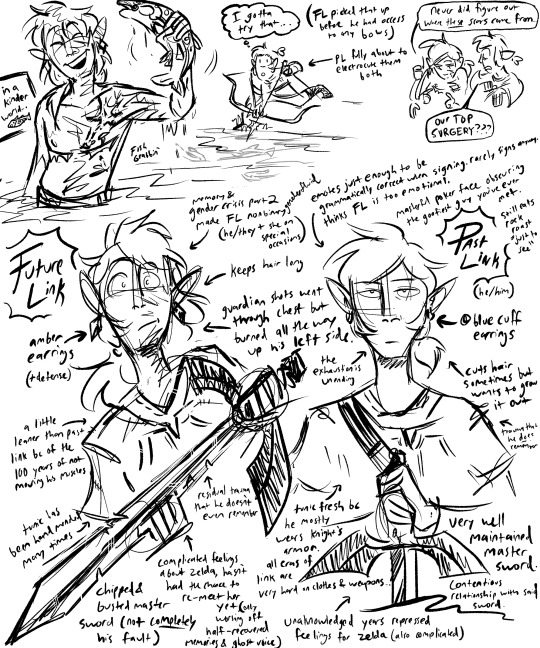
notes on past and future link
#specifically for this au. i have slightly different feelings about canon bc i think PL is less of a hardass bc he doesnt Know what happens#calamity unwritten#calamity unwritten comic#loz#botw#hyrule warriors#hyrule warriors age of calamity#time travel au#zelda#link#loz link#digital art#art tag#comics#comic#and sillies#in case you were forgetting how much of a self indulgent au this is im introducing you to my 10 page essay on link's gender journey#Past link has been changed by the circumstances and the burden of knowledge. hes usually sillier around at least zelda but now he feels#like he has to be Extra Closed Off because of how open future link is. there will be more notes in the future i have a lot of thoughts that#i cant always cram into the comic. though its all in there Technically#in the subtext#ignore what time im posting this ill queue it for normal hours. later.
115 notes
·
View notes
Text
Still trying to collect my thoughts after the finale, but one of the many things I love about the final conversation between Hawk and Tim is how clearly Tim has moved on – not by forgetting about Hawk or because he didn’t love him anymore, but by accepting that his own love for Hawk was enough. He didn’t expect more, he didn’t need more.
Hawk, on the other hand, has constantly been running away from his love for Tim, unable to admit how important Tim essentially was for him. I found it almost funny how he asked “Don’t you need me?” back in episode 7, because it is very clear at that point that Hawk needs him much more than Tim needs Hawk. But the problem is that Hawk never wanted to need Tim; never wanted to be in love with him. Tim has been honest within his feelings for Hawk, which has allowed him to find peace. Hawk has never been able to do that.
It was clear from the beginning that Tim needed someone like Hawk in his life – someone that represented love and passion to him. He also found that love and passion in Church and within his idolization of McCarthy. But Hawk allowed him to be authentically himself – something that neither his faith nor his political beliefs, and not even his family, could give him.
Besides being fond of him, I believe that Hawk very much admired Tim from the very beginning. He admired Tim’s care and passion, because those are the exact things Hawk was missing and needed in his life. The last scene of the first episode already shows that Hawk needs Tim – needs his comfort and compassion.
Essentially, Hawk is the only person in Tim’s life that Tim feels like he can truly be himself with. And Tim is the only person in Hawk’s life that Hawk can allow himself to be vulnerable with.
Hawk is fine with the way their relationship continues because it is always on his terms. Tim is there for him and he doesn’t need more. But Tim clearly struggles within it, because he does need more than Hawk can give him. He doesn’t just want to eat dinner in a restaurant, pretending Hawk is his uncle, but he wants to eat dinner in a restaurant while letting everyone know that this is the man he loves.
Then Hawk decided to end their relationship at the worst time possible: the one time that Tim truly needed Hawk. At this point, they are both aware that Tim has to let go of Hawk, yet neither can admit that Hawk has to let go as well. As a result, Hawk wants to reunite with him in ’57, and Tim relents, but with different expectations – ready to have the casual affair Hawk always wanted. I think the scene of them dancing together naked is a quite pivotal scene on why this didn’t work. For one, Tim is clearly unable to just be casual about anything. But it also shows that Hawk very clearly can’t have anything casual with Tim anymore either.
Tim then continues his search for something more – searching for what he found with Hawk but knew very well Hawk could not give him. First, he’s returning to his faith, trying to become a priest. Then he becomes a social worker. And, throughout all this, he’s still passionate about his political beliefs – and while those beliefs have changed over the years, the root to it all is still his compassion and care. He also moves to San Francisco, choosing to be authentically himself by coming out, and living within a queer community. He doesn’t need Hawk anymore. He still loves him, but he doesn’t need him.
Hawk, however, has never tried to look for the comfort Tim has given him elsewhere. He pushed Tim out of his life when he believed that he had to, then tried to reconcile when it was convenient for him. Because, in the end, even his family could not give him the same love and care, as he constantly felt like he had lie to them. And don’t get me wrong, Hawk clearly loved his family, but he never found the same comfort with them as he had with Tim, because with Tim he could be vulnerable in a way that he has never allowed himself to be with Lucy or their children.
However, after Tim leaves him in ’79, I do believe that he is trying his best to let Tim go. He’s become much more caring when we meet him in ’86, possibly allowing himself to find comfort and happiness in the life he has built with his family.
At this point, Tim has found peace within his feelings for Hawk. He doesn’t need him anymore, but neither does he regret anything. He still loves him, but that love is enough for him. He’s not searching for more, because he’s already found it.
And this is perhaps the first time that Hawk is truly there for Tim – deciding to stay with him, standing by his side, showing his love for him publicly and eventually admitting it to his daughter. And while I believe that Hawk has been more or less aware of his feelings for Tim since the 50s, I also believe that he only truly admitted it to himself after everything was over. His confession to his daughter was also a confession to himself.
#fellow travelers#ft spoilers#not sure how much sense i make i'm still recovering from the finale#i have so many thoughts about this damn show i could probably write a million essays#hawkins fuller#tim laughlin#hawk x tim#meta
92 notes
·
View notes
Text
My take (or well ig dispute) on the Traveler is Jack's dad theory
Honestly, I've been having these thoughts on this theory ever since I saw the post, but now seems as good a time as ever to actually talk about it. *Slowly looks behind me while the Night Swan event is looming behind my back*
Disclaimer: for this post I am completely putting aside my theories on who Jack's dad could be, and the fact I am a WanderRose shipper. These factors so not exist to me right now.
This has become an essay so I'm going to create a little cut off to save your feed lol. Please do read it though if you have the time.
The clones/reflections
Starting out I would like to talk about the clones that appear in Treasure and Rock Your Body that seemed to be the root of this theory. They also mentioned Locked out of Heaven, but those are reflections in a mirror and not clones.
I don't think Jack has the ability to create clones. Period, done that's it. I know that in Treasure we see clones of Night Jack dance alongside him, but I don't think these come from Jack's magic (or lack thereof) at all. As Treasure is a map where Night Swan shows Jack what he could have been, what he could be if he just joins her side again. So I think that just like everything else in Treasure, the clones were created with Night Swans magic and have nothing to do with Jack's abilities. I think Night Swan can create clones of herself if she wanted to, but she doesn't because she has her minions to do the dirty work, so she utalizes this ability to give Jack an idea that if he joins her side that he too can shape people's mind in a way where they'll think just like him as if they were clones of him. Which would be another case of Night Swan thinking Jack wants something while he really doesn't.
Overall I do not think it would make sense for Jack to be able to create clones, since it would do absolutely nothing for the story. Plus if he does, why wouldn't they have used that by now? They could have utilized this in Majesty or something to show that he can, since they didn't hesitate with the portal thing Night Swan had going on. On the other hand I feel it would make more sense for Night Swan to be able to create clones as that puts her magic level around the same leven the Traveler has. Which makes her an even better antagonist in my opinion. Also they could actually do back story stuff with that but I'll get into that later.
The blatand cheating or at least very suspicious implications??
This one is just ovbious to me, like it doesn't matter if he was with Night Swan first or with Si'ha first in this case. Wanderlust and Jack are very much around the same age i think, presonally I believe Jack to be younger but that doesn't really matter right now. Either way, this means that the Traveler would have been with a woman, had a child and then up and left her to have a child with another. That's AITA redit story typa shit that I don't think Just Dance is going to pull. Let alone when those two women are the Queen and probably one of the most powerful sorceresses in the entire danceverses.
But let's disect it for a moment anyways.
Option 1: Wanderlust's older, Jack's younger right. This would mean that the 2020 story line happened as we know it right now. The Traveler searched across all of the danceverses for Si'ha Nova and eventually he found her. They fell inlove, they got married, they had Wanderlust. The most popular love story of the danceverses. And then the Traveler gets up like what a few months, a year, into his happy family and cheats on Si'ha Nova with Night Swan (who might not be evil by now, but still). Now you can argue that they got divorced and shit but that's highly unlikely in my opinion. Since a big part of the Traveler and Si'ha's characters is their love story. Plus even then there would have to have been some emotional cheating because you don't just fall in love with someone enough to have a child with them that fast. Yes, you could argue that Jack was a child created out of wedlock but that's really reaching at that point isn't it.
Option 2: Jack's older, Wanderlust's younger. This just means we can throw the entire backstory of the Traveler and Si'ha Nova out of the window. Why would you get with someone while actively searching for the so called love of your life? It just doesn't make sense to me. And you can't even argue that it wouldn't have happened because there is no way that Jack is that much older than Wanderlust.
Overall I think that the implicastions this brings is too much for Just Dance. I know that there's songs about being cheated on in the game, but why would they build up such a love story just to throw it out of the window?
Jack's design
This one is 100% from my side, but as someone who lives for character design I'm going to be real. If the Traveler was Jack's father we would have seen that in little hints in his design, even if Night Swan wanted to surpress that as much as possible for some reason. Ubisoft is one of the big game design companies and would know to incorperate at the very least a small little detail hinting towards it. Something like a little bit of blue or a triangle or something you know.
Plus this is something I'll always point out but: it would make even less sense for him to have bright red hair. I know that genetics probably work wildy different in the danceverses than here, but come on. I highly doubt that a character who's parents both have dark hair would have bright red hair without any good reason for it. You want your characters to at least resemble their parents. Why would they do that with Wanderlust and not with Jack? That doesn't make any sense.
Afterthought
Honestly, if they do end up adding it. It just feels like a weird afterthought they put in for people to stop shipping WanderRose. It's the only ship they seem to have beef with and I feel like they would be adding it just so they have a good reason to have beef with the ship. It genuinely doesn't feel like they properly planned for it or anything. Honestly, if you're going to be that petty about a ship you should really reflect as a company lol.
What could they do instead?
I do have an idea for that, because there was a lot of Night Swan and the Traveler teasing going on in the y2k season, and while I think one of the maps we're getting will be Sweet Dream there's still a second map. If they want to get into the backstory between Night Swan and the Traveler, I think that it would be really cool if they like studied flow under the same master or something and that's where a rivalry started. They could still do something with the two, but it wouldn't have to feel lazy and rushed just because they don't want a ship. But that's just my thoughts on that matter.
In conclusion
The Traveler...

And being honest? I don't think we're going to find out who Jack's father is. I think we might just be getting two solo maps of Night Swan. Or maybe even Sweet Dreams and Lose Yourself, proving that that's preETDV Jack.
But those are just theories, a game Just Dance theory. If you have anything you'd like to say or if you wanna duke it out with me about this. Feel free to. I like hearing other peoples opinions on things like this.
Okay really if you have made it this far. Thank you?? How did you get through all that bullshit jezus- I truly didn't intend for this post to become a sort of essay, but it appears it has. I hope everyhting made sense since I tend to explain shit in weird ways.
Anyways have this meme because I'm like super relevant and a totally normal person.

#I should start making essay youtube videos istg LOL#This theory has us all stressing lol#jack rose jd#jack rose#jack rose just dance#jd the traveler#the traveler#night swan jd#night swan just dance#just dance#just dance fandom#just dance 2024#just dance coach#jd#just dance theory
45 notes
·
View notes
Text
If I see one more person in the comment section of a Fellow Travelers TikTok calling Hawk a villain I might actually end it all
#it’s always on TikTok and they always give the worse reasons#Hawk’s mischaracterisation makes me feel rage on a level I haven’t felt rage before#might end up writing an essay on it or something tbh#fellow travelers#hawkins fuller#hawk fuller#matt bomer
38 notes
·
View notes
Text
The thing about time travel fics for Star Wars is that if you want to redeem Anakin Skywalker, you can’t throw whichever character of your choosing back to just before Order 66, or even in the middle of the war.
If you want any chance of redemption for Anakin’s character, you have to prevent the Tusken massacre. Say what you want about how they tortured and killed his mother, and even if you can justify the adult m*rder, I draw the line at child m*rder. All these time travel fics sending him to therapy and nothing else; actions have consequences and he should see them.
Also, it’s incredibly fucked up that he admitted all this to Padme and SHE STILL MARRIED THE GUY!
Like I don’t know about y’all, but I would find that horrifying and highly concerning especially in relation to my own safety, which I guess in the end actually comes to pass.
#tbh I could write a short essay on how padme was problematic#like I want to like her character for supposedly being a boss bitch but then I remember shit and cringe#poor obiwan as he’s the one who usually gets thrown back in time to fix everything#he needs a vacation#star wars#anakin skywalker#star wars anakin#padme amidala#time travel#obi wan kenobi#ahsoka tano#the clone wars
25 notes
·
View notes
Text
‘Pimpernel of the Hellenes’, ‘Major Paddy’, ‘Enchanted maniac’: Will the real Paddy Leigh Fermor please stand up?
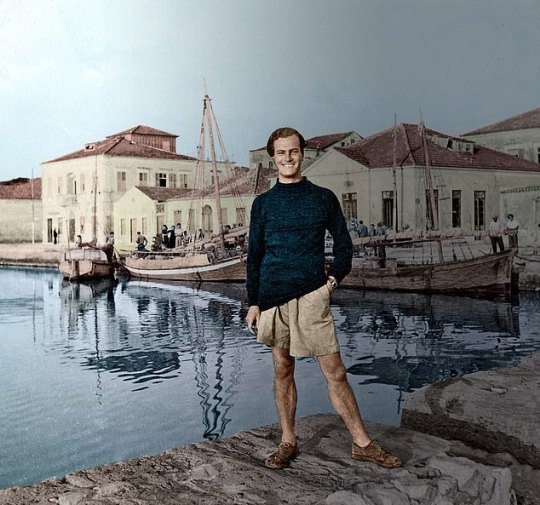
Paradox reconciles all contradictions.
- Patrick Leigh Fermor
So one evening I was baby sitting my nephews and nieces here in our family chalet in Verbier, high up in the Swiss Alps. It was my turn to baby sit as the rest of my family enjoyed the fantastic classical music concerts and events showcased at the two week long Verbier 30th Festival. The little scamps had gone to bed and my father and I watched an old British war movie on DVD, ‘Ill Met By Moonlight’ (1957). It was filmed by the legendary team of Michael Powell and Emeric Pressburger based on the 1950 book ‘Ill Met by Moonlight: The Abduction of General Kreipe’ by W. Stanley Moss.
I’ve seen the film a couple of times before, but until now never really paid attention to where the title came from. My father said it was from Shakespeare’s ‘A Midsummer’s Night’s Dream’ And so it was. In the play, Oberon, the king of the fairies and the Queen are having a fairly bitter drawn-out fight over custody of a changeling Indian child, and this is how the pissed off king greets the queen when they run into each other, “Ill met by moonlight, proud Titania”. Oberon is basically saying "Oh Lord, it's you..." and Titania's response is basically a flippant middle finger. One of the best modern reasons to read Shakespeare: to throw playful erudite shade at others.
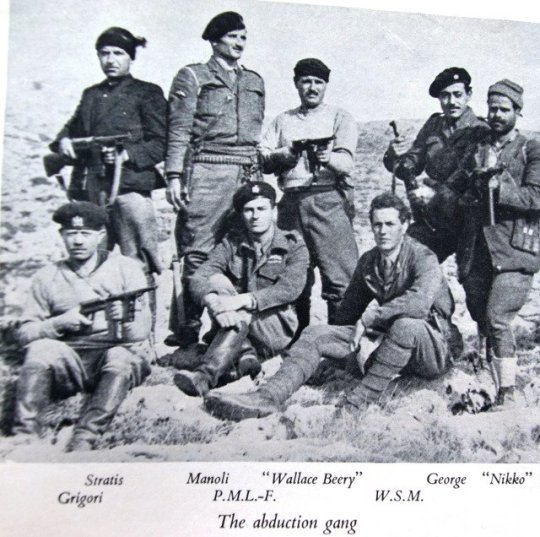
Anyway, the historical background of the film is the German invasion of Crete in May 1941. After an intense ten-day battle, Allied troops were driven back across the island, and many were evacuated from beaches along the southern coast. Some Cretans and British officers took to the mountains to organise resistance against the occupying forces. The German occupation that followed was especially brutal. Dreadful reprisals followed every act of resistance. The German commander, General Müller, insisted on taking 50 Cretan lives for every German soldier killed; he became known as ‘The Butcher of Crete’.
As a Classicist side note, there had been a close association between Britain and Crete since the early 20th century, when archaeologist Sir Arthur Evans had uncovered the sensational remains of a Minoan palace at Knossos. The headquarters of the British archaeological school in Crete was a large villa alongside the site, known as Villa Ariadne. Several archaeologists, who knew the island and its people well, went underground after the German occupation to aid the Cretan resistance. Continuing in this tradition, scholar and travel-writer Patrick Leigh Fermor, who had got to know Greece in the 1930s, joined the Special Operations Executive (SOE).
During the German occupation, Major Paddy Leigh Fermor travelled to Crete three times to help organise local resistance against the hated German occupation. On the third occasion, in February 1944, he was parachuted in with a specific mission to kidnap German commander General Müller, to boost morale on Crete along with his erstwhile SOE comrade Capt. W. Stanley Moss MC (aka Billy Moss) of the Coldstream Guards. However, just after they parachute in, General Müller was replaced by General Heinrich Kreipe, who transferred from the Russian Front. Thinking that capturing one general was as good as another, Fermor merrily go ahead with the daring kidnap operation.
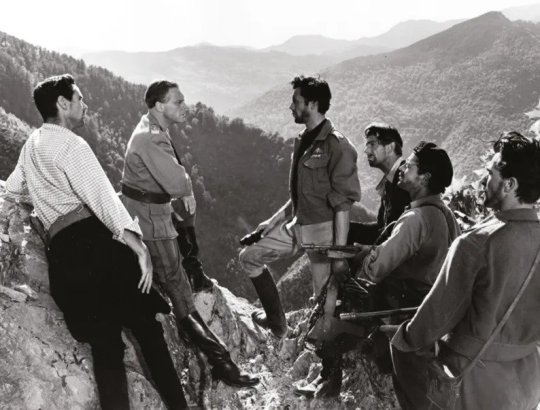
It’s at this point that the narrative of Michael Powell and Emeric Pressburger’s ‘Ill Met by Moonlight’ (1957) picks up. Dirk Bogarde plays Paddy Leigh Fermor, David Oxley plays Moss, and Marius Goring plays the taciturn German paratroop general. Blink and you’ll miss the late great Christopher Lee making a cameo appearance as a German officer in the dentist’s room scene.
The film naturally takes some liberty with the facts but it’s a cracking yarn of high adventure and drama. Xan Fielding, a close friend of Leigh Fermor from the SOE in Cairo, was taken on as technical adviser. The fact the film was shot in in the Alpes-Maritimes in France and Italy, and on the Côte d'Azur in France, far away from the craggy valleys and mountains of Crete itself. The director Michael Powell spent some time walking in Crete to get to know the island, but decided that, with the confused and volatile state of Greek politics, it was not suitable to film there.
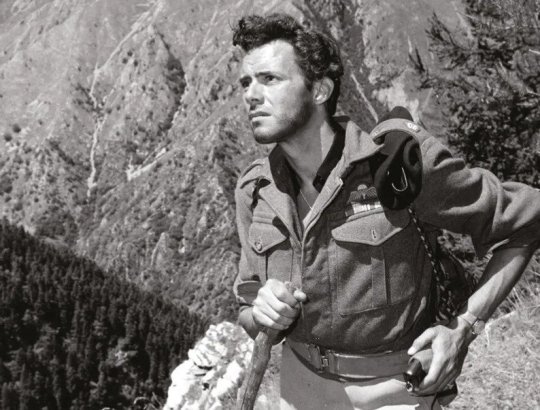
Looking back years after he had directed it Powell didn’t think much of his own film. By contrast, Paddy Leigh Fermor, who was on set throughout the film shoot, was very happy with Bogarde’s portrayal of him with Byronic glamour. Watching the movie again ‘Ill Met by Moonlight’ remains a classic and stands out from many British war films of the 1950s because of its realism. The British SOE men and the Cretan guerrillas look absolutely right for their parts. It is dramatic and full of suspense while filled with much boyish humour.
I was disappointed with one notable omission in the film that did happen in real life. According to Patrick Leigh Fermor, at dawn one day during the journey across the mountains, General Kreipe was looking at the mist rising from Mount Ida and began to recite, in Latin, the opening lines of Horace’s ninth ode:
Vides ut alta stet nive candidum
Soracte nec iam sustineant onus
silvae laborantes geluque
flumina constiterint acuto?
Behold yon Mountains hoary height,
Made higher with new Mounts of Snow;
Again behold the Winters weight
Oppress the lab’ring Woods below:
And Streams, with Icy fetters bound,
Benum’d and crampt to solid Ground
(John Dryden 1685)
Leigh Fermor picked up on the General, and recited the remaining stanzas of the Ode. ‘Ach so, Herr Major,’ said Kreipe when Leigh Fermor had finished. Both men were amazed to realise they shared a classical education and a love of ancient Latin poetry.
Leigh Fermor later wrote that it was as though the war had ceased to exist for a moment, as ‘We had both drunk from the same fountains before.’ It brought captor and captive together with a strange bond. The scene was not reproduced in the film, as Powell and Pressburger probably thought it would make the men sound too academic for a popular cinema audience.
Leigh Fermor and Kreipe met again in the early 1970s, on a Greek television show, and got on famously together. The General said Leigh Fermor had treated him chivalrously as a captive. They remained friends until Kreipe’s death.

After sharing a late night drink with my father after the film, I began to muse on the figure of Paddy Leigh Fermor, a family friend and someone I met along with his wife, Joan, as a little girl. My grandparents, and especially my grandmother, knew Paddy briefly from their days during and after the Second World War.
My father shared a few stories about him when he and my mother visited his beautiful home in Greece, where even at his advanced age he remained the most generous of hosts and the most outrageous flirt.
One of my memories was getting into his battered old Peugeot in the drive way and trying to drive it when my feet could barely touch the pedals. It wouldn’t have mattered in any case as the brakes didn’t work as he cheerfully said later as we careened around a dirt road to go around the mountains for a drive.
Many years later in April 2022, I tried to visit the home of the late Patrick and Joan Leigh Fermor - a sort of pristine shrine to their memory that one can also stay in any of the rooms as a vacation rental - in the coastal fishing village of Kadarmyli in the Peloponnese, as part of a hiking and mountaineering sojourn around Greece with ex-Army friends. We couldn’t stay there as it was already rented out to other guests, and so we stayed higher up the mountain in a villa, but we swam in front of the Fermor’s home which was on the water’s edge.
You could never put your finger on Paddy Leigh Fermor. He hid behind his gift for telling yarns, and pulling Ancient Greek verses out of the thin air, as well as boisterously singing local Greek songs with a drink in his hand.
Even after his death in 2011, the question keeps nagging as to who was Paddy Leigh Fermor?
The Dirk Bogarde film too seems to ask, who exactly is the ‘real’ Patrick Leigh Fermor - or the real anyone? Taking its title from a Shakespearian play concerned with dreams and disguises, magic and power, ‘Ill Met By Moonlight’ is all about questions of identity.
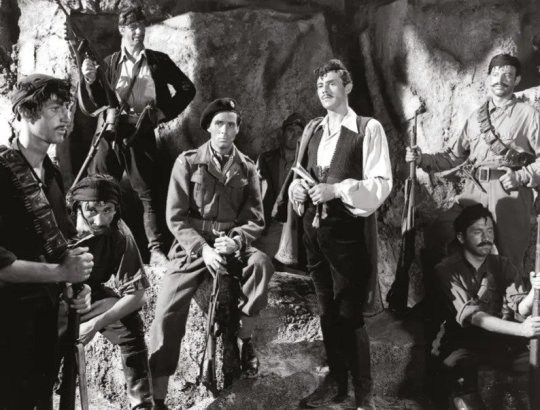
Under the film credits, we see Dirk Bogarde in uniform; then, unexpectedly, we see him in the flamboyant outfit of a Cretan hill-bandit. A title informs us that Major Leigh Fermor was also known by the Greek code-name “Philidem.” In other words, there are two of him (at least), and on one level the adventure the film is about to unfold reflects a conflict in his personality. It’s a conflict shared, unknowingly, by his Nazi opposite number, the fierce, arrogant General Kreipe (an unlikely “proud Titania,” but it’s true that he “with a monster is in love” – the monster of Nazism). Kreipe’s human side is so rigorously repressed by the demands of war and “glory” that he is genuinely unaware of it; ironically, this humanness, which constitutes the true manhood of this Teuton warrior, is revealed by a boy (equivalent to Shakespeare’s Indian Prince?) - who, in turn, is the most grown up person in the movie.
If “Philidem” appears under the credits, caped and open-shirted, a romantic dream-figure out of an operetta or a storybook, he is first seen in the film proper as a coarser, more down-to-earth version of the same thing – an ordinary Cretan peasant in a shabby suit, waiting for a bus. When he makes contact with the Resistance, his personality fragments further.
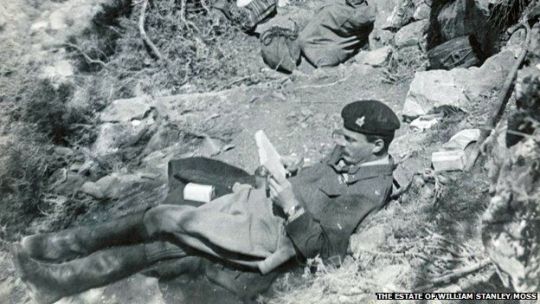
To some, he is the mystical Philidem, Pimpernel of the Hellenes and righter of wrongs. To others he is “Major Paddy,” the happy-go-lucky Englishman of popular movie myth conducting war as if it were a branch of amateur theatricals, a gentleman adventurer relying on breeding to get him through and making fun of the whole business. To Bill Moss (David Oxley), the newly arrived junior officer sent to assist him, he is the cool, fast-thinking professional soldier. And to himself? In his quietly passionate defence of Cretan life and culture, he seems someone else again: a scholar and aesthete outraged by the barbarism and folly of war, and by the moronic arrogance shown by his captive toward the Cretan people.
Whatever his persona, Leigh Fermor is a chameleon who never seems to change very radically in himself. Perhaps because he has this quality of seeming all things to all men – and being those things - he remains unfazed by the monolithic might of the German military machine. Fluent in Greek, he can also speak German like a German and is easily able to assume another disguise, that of a faceless Nazi officer. Although he and Moss make fun of themselves - “If only I had a monocle!” muses Moss when Leigh Fermor tells him he “looks like an Englishman dressed like a German, leaning against the Ritz bar” - they are able to effect the kidnapping with an ease that seems appropriately Puckish. General Kreipe is ignominiously thrust onto the floor of his own limousine, gagged, and sat upon by a couple of the peasants he so despises. Kreipe’s rage is compounded by his firm conviction that he has been snatched by “amateurs” - a belief Leigh Fermor and Moss slyly make no objection to, knowing how it will gnaw at his already shaky Master Race self-confidence.
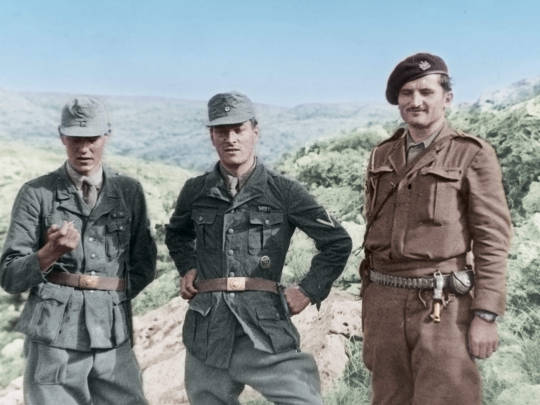
Patrick Leigh Fermor, aka Major Paddy, aka Philidem, in the film’s closing moments, is far from being self-assured intellectual or dashing amateur adventurer or legendary outlaw of the hills. He’s just a tired man who wants to go home and rest up. “How do you feel?” asks Moss. “Flat” is the reply. “You look flat!” says Moss. “I know how I’d like to look …” murmurs Leigh-Fermor wistfully. Moss knows what he’s going to say, and joins in the litany: “Like an Englishman dressed like an Englishman – and leaning against the Ritz bar!” It’s easy to imagine them ordering drinks at that renowned watering-hole with all the suavity required by this little fantasy.
Still, the film’s last images of Crete receding in the distance, until all we can see is the sea, suggests that maybe Major Paddy’s heart is really back in those hills in the “fair and fertile” land that has become as much a Powellian landscape of the mind for us as the studio-built Himalayan convent of ‘Black Narcissus’ or the monochrome Heaven of ‘A Matter of Life and Death’. And, as the film POV closing shots departs both Crete and this film, I began to think that being “dressed like an Englishman and leaning against the Ritz bar” would, for Patrick Leigh Fermor constitute yet another disguise. After all, he said he was of Irish aristocratic stock.
Traveller and writer Paddy Leigh Fermor is best known for two events. He’s known for leading the commando group in occupied Crete to kidnap General Kreipe. But he is also known for the boy who, at a mere 18 years old, set off with little money and a lot of nerve in 1933 to walk from the Hook of Holland to Constantinople.
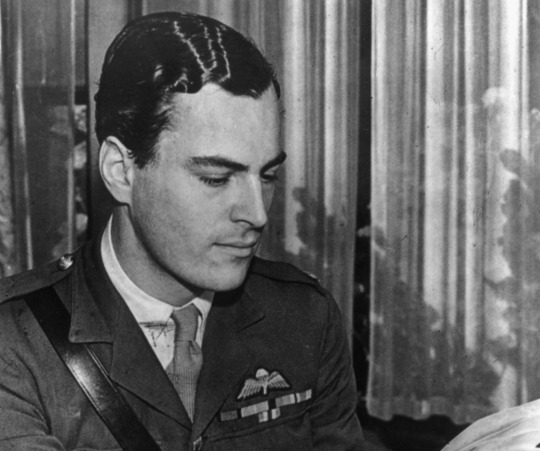
Patrick Leigh Fermor was, in the words of one of his obituaries, a cross between Indiana Jones, James Bond and Graham Greene. Self-reliance and derring-do were lessons learnt from the cradle. When Fermor’s geologist father was posted to India, he and his wife left the infant with family in Northamptonshire and did not return until his fourth birthday. In retrospect, he took great delight in being sent to a school for difficult children and getting himself expelled from the King’s School, Canterbury, when he was caught holding hands with a greengrocer’s daughter eight years his senior. His school report infamously judged him ‘a dangerous mix of sophistication and recklessness’.
Sharing a flat in Shepherd’s Market, one of Mayfair’s seedier corners, Leigh Fermor schooled himself in literature, history, Latin and Greek.
He honed his character with the company of extraordinary people and the words of great writers - he had a prodigious memory for prose as well as poetry. He befriended literary lions such as Sacheverell Sitwell, Evelyn Waugh and Nancy Mitford. His travels began aged ‘eighteen-and-three-quarters’ when he rejected Sandhurst Royal Military College in order to walk the length of Europe from Hook of Holland to Constantinople. He took with him Horace’s Odes and the Oxford Book of Verse though Leigh Fermor could recite Shakespeare soliloquies, Marlowe speeches, Keats’s Odes and as he modestly put it ‘the usual pieces of Tennyson, Browning and Coleridge’ from memory.
Leigh Fermor was then a self-made man in the most literal sense.

Setting off from England in 1933, Fermor resolved to traverse Europe living like a hermit; sleeping in bars and begging for food. But his manly charms and boyish good looks found him being passed like a favourite godson from Schloss to palace by European nobility and he developed a lifelong penchant for aristocratic company. I his own words, ‘In Hungary, I borrowed a horse, then plunged into Transylvania; from Romania on into Bulgaria’. Having reached Constantinople in January 1935, Fermor continued to explore Greece where he fought on the royalist side in Macedonia quelling a republican revolution. In Athens Leigh Fermor met Balasha Cantacuzene, a Romanian countess with whom he fell in love. They were living together in a Moldovan castle when World War Two was declared.
Fluent in Greek, Leigh Fermor was posted as a liaison officer in Albania. Recruited as a Special Operations Executive (SOE), he was shipped from Cairo to German-occupied Crete where he lived disguised as a shepherd in the mountains for two years. On his third expedition to Crete in 1944, Leigh Fermor was parachuted alone onto the island and made connections in the Cretan resistance movement. While waiting for his compatriot Captain Bill Stanley Moss to land by water from Cairo, Leigh Fermor hatched a plot to kidnap German Commander General Heinrich Krieple. He liaised comfortably with Cretan partisans and bandits to pull off one of the war’s greatest coups de théâtre.

Disguised as German soldiers, Leigh Fermor and Moss stopped Krieple’s car at an improvised check point en route back to Nazi HQ in Knossos. Abandoning the General’s car after a two-hour drive, Leigh Fermor left a note indicating that the kidnappers were British so that there wouldn’t be reprisals against Cretan nationals. When the abduction of the unpopular commander was discovered, a German officer in Heraklion allegedly said ‘well, gentlemen, I think this calls for champagne’. It turns out that General Kreipe was despised by his own soldiers because, amongst other things, he objected to the stopping of his own vehicle for checking in compliance with his commands concerning approved travel orders. It’s why for instance the German troops, both in the film and in real life, dare not stop the General’s car as it drove through the check points at Heraklion.
Krieple was evacuated and taken to Cairo and Leigh Fermor entered the annals of World War Two’s most devil-may-care heroes. With characteristic panache, when he was demobbed Leigh Fermor moved into an attic room at the Ritz paying half a guinea a night. But his first travel book, ‘The Traveller’s Tree’, was not about the European odyssey or the Cretan escapades and centred on Leigh Fermor’s adventures in the Carribbean. Published in 1950, ‘The Traveller’s Tree’ was an inspiration for Ian Fleming’s second James Bond novel ‘Live and Let Die’ (1954).
As a host and house guest, Paddy Leigh Fermor was much sought-after. At one of his parties in Cairo, he counted nine crowned heads. He was a confirmed two-gin-and-tonics before lunch man and smoked eighty to 100 cigarettes a day. His party pieces included singing ‘It’s a Long Way to Tipperary’ in Hindustani and reciting ‘The Walrus and the Carpenter’ backwards. In Cyprus while staying with Laurence Durrell, Leigh Fermor apparently stunned crowds in Bella Pais into silence by singing folk songs in perfect Cretan dialect. As Durrell wrote in ‘Bitter Lemons’ (1957), ‘it is as if they want to embrace Paddy wherever he goes’.
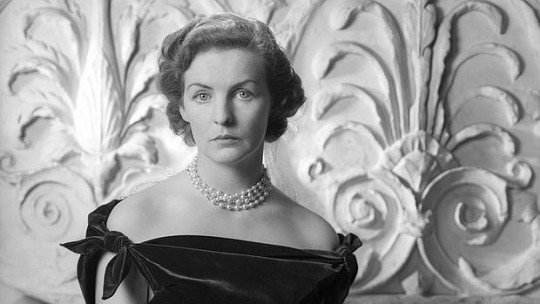
He struck up a partiuclar friendship with the famous Mitford sisters, especially Deborah Mitford, later ‘Debo’, the Duchess of Devonshire. It was at the Devonshires’ Irish estate Lismore Castle that ‘Darling Debo’ and ‘Darling Pad’ met and began to correspond. A characteristic letter from the Duchess in 1962 reads ‘The dear old President (JFK) phoned the other day. First question was ‘Who’ve you got with you, Paddy?” He’s got you on the brain’ to which Fermor replies of a broken wrist ‘Balinese dancing’s out, for a start; so, should I ever succeed to a throne, is holding an orb. The other drawbacks will surface with time’.
After the war he travelled widely but was always drawn back to Greece. He built a house on the Mani peninsula - which had been, significantly, the only part of Magna Graecia to resist Ottoman colonisation since the fall of Constantinople in 1453. Before his death in 2011 at the age of 96, he wrote some of the most acclaimed travel books of the 20th century.
His books contain some of the finest prose writing of the past century and disprove Wilde's maxim that "it is better to have a permanent income than to be fascinating".
Charm, self-taught knowledge and enthusiasm made up for the lack of a university degree or a private income. His teenage walk across Europe and subsequent romantic sojourn in Baleni, Romania, with Princess Balasha Cantacuzene are proof enough of that. But the difficulty of capturing such an unconventional and glamorous life is made harder by the certainty that Fermor was an unreliable narrator.

He was also an infuriatingly slow writer. Driven by a life-long passion for words yet hampered by anxiety about his abilities, Leigh Fermor published eight books over 41 years.
‘The Traveller's Tree’ describes his postwar journey through the Caribbean; ‘Mani‘ and ‘Roumeli’ (1958 and 1966) draw on his experiences in Greece, where he would live for much of the latter part of his life. But it is the books that came out of his trans-Europe walk that reveal both the brilliance and the flaws. ‘A Time of Gifts’ was published in 1977, 44 years after he set out on the journey. ‘Between the Woods and the Water’ appeared nine years later. Both describe a world of privilege and poverty, communism and the rising tide of Nazism, and end with the unequivocal words, "To be continued". Yet the third volume hung like an albatross around the author's neck. As the years passed, Fermor found it impossible to shape the last part of his story in the way he wanted.
Leigh Fermor was that rarest of men: a man determined to live on his own terms, if not his own means, and who mostly - and mostly magnificently - succeeded. Always popping off on a journey when he should have been writing about the last one, always ready to party, he was forever chasing beautiful, fascinating or powerful women, even when with his wife, Joan Raynor. She was the great facilitator who funded his passion for travel and writing, as well as women, from her trust fund. His love affairs were discreet but legendary.
Leigh Fermor was happiest among the rogues. Over a lifetime on the road, he sought them, and in turn they responded to his charm, nose for adventure, and his famous wit. He was a keenly-anticipated dinner guest - once outshining Richard Burton at a London society soirée, who he cut-off midway through a recital of ‘Hamlet’. As Richard Burton stormed out, the pleading society hostess said, “But Paddy’s a war hero!” to which Burton grouchily replied, “I don’t give a damn who he is!”
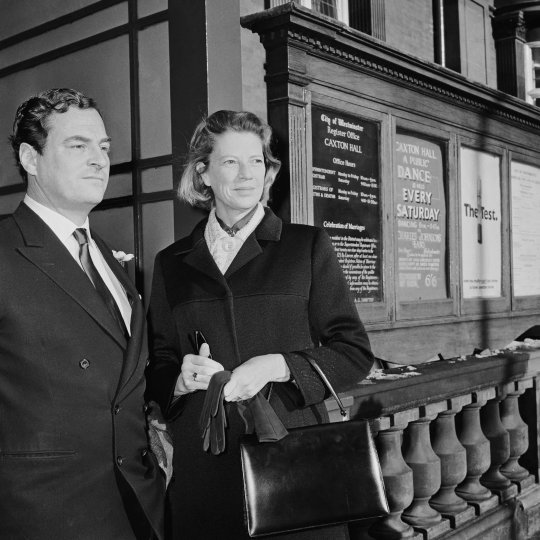
His partnership with and then marriage to Joan Raynor was an open relationship, at least on Leigh Fermor’s side. Paddy saw in Joan his kindred spirit. Like him, she spent much of her youth travelling to where she pleased; largely in France, where the photographer and literary critic Cyril Connolly became besotted by her. Joan was the daughter of Sir Bolton and Lady Eyres Monsell of Dumbleton Hall, Worcestershire. She was not only stunningly pretty but also 'a beautiful ideal, with the perfect bathing dress, the most lovely face, the most elaborate evening dress', as the Eton educated Connolly described her. Joan also stood out from the upper-class beauties of her day in that she supplemented her mean rich father's allowance by earning her living as a decent photographer.
In 1946, she met Leigh Fermor in Athens, while he was deputy director of the British Institute. Joan met him at a time when he was then in a relationship with a French woman called Denise, who was pregnant with his child, which she aborted. The pair would travel to the Caribbean together under the invitation of Greek photographer Costas, falling madly in love.

She was the only woman that - after decades of sexual scandals - matched his own erratic behaviour. Stories of how they dined fully-clothed in the Mediterranean, dragging a table into the sea, as well as their myriad cats and olive groves, paint a restless couple, who, when not out articulating the peoples of their adopted homeland, kept themselves very busy.
The attraction between Paddy and Joan was instant. So many love affairs that Paddy indulged in seemed about as brief as the flame from a burning envelope and you expected this one with Joan to be too. But somehow, miraculously, it lasts.
The two were apart a great deal, but in their case, absence did make the heart grow fonder. While Paddy was staying in a monastery in Normandy, supposed to be thinking monk-like thoughts that he would eventually put into his masterpiece A Time To Keep Silence, he was also writing sexy letters to Joan: 'At this distance you seem about as nearly perfect a human being as can be, my darling little wretch, so it's about time I was brought to my senses.' And: 'Don't run away with anyone or I'll come and cut your bloody throat.'
She tantalised him with descriptions of Cyril Connolly making passes at her; but she, like Denise, sounded a rather desperate note when she wrote: 'I got the curse so late this month I began to hope I was having a baby and that you would have to make it a legitimate little Fermor. All hopes ruined this morning.'
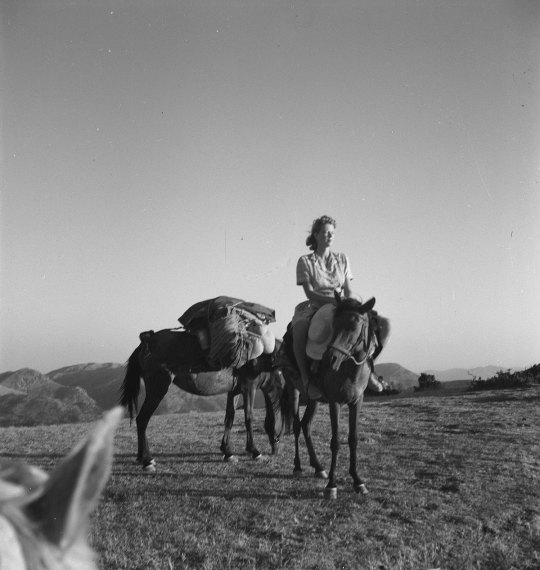
Fiercely independent - a trait that must have enamoured Paddy - they were best imagined as two pillars of a Greek temple, beside one-another but capable of holding up the roof of the world that they had built for themselves through the lens of ancient history and Hellenic culture. Indeed, it was said that they had a special ‘pact of liberty’. It is this unconquerable aura that led poet laureate John Betjeman to declare his love for her (he called her ‘Dotty’ and remarked that her eyes were as large as tennis balls). For Cyril Connolly, the photographer she shadowed, and with whom she had a scandalised affair during her first marriage, she was a “lovely boy-girl” and Laurence Durrell named her the ‘Corn Goddess’ because of her slender figure and short hair. But of all of these worthy candidates, it was the warrior-poet Patrick Leigh Fermor who finally won her heart.
To Joan, who described herself as a ‘lifelong loner’ in her diaries, her companionship with the uncomplicated Paddy was a relief. They had no children, nor did they want any - or so Paddy claimed. But those who knew Joan suspected she did want children but it never came to pass; and so she became a devoted aunt or dotted on other friends’ children. For both of them their dozens of cats gave them the next best thing to paternal satisfaction. Still, her morbid fascination with photographing cemeteries painted a much darker side.
Joan Raynor’s inheritance subsidised his peripatetic life at least until the enormous success of ‘A Time of Gifts’ in the late 1970s, which in turn created a new market for his previous volumes about Greece, ‘Mani’ and ‘Roumeli’.
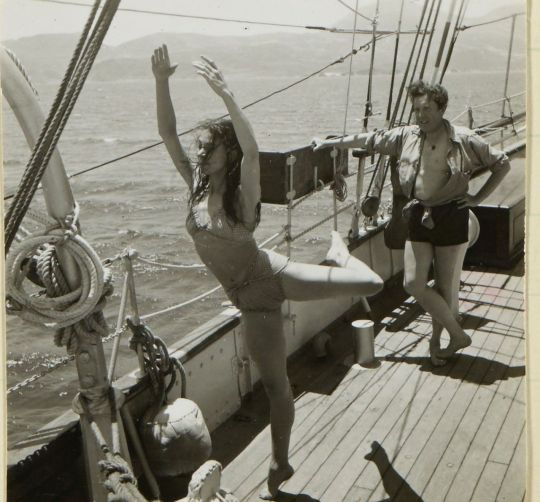
With Joan’s tacit consent, Paddy enjoyed amorous flings, discrete sexual affairs with high society women and sampled the low delights of the brothel. This activity rarely made it into his private letters, but the exceptions could be piquant. Writing in 1958 from Cameroon, where he was on the set of a John Huston movie, he told a (male) friend: “ Errol Flynn and I . . . sally forth into dark lanes of the town together on guilty excursions that remind me rather of old Greek days with you.” In a 1961 letter to the film director John Huston’s wife, Ricki, with whom Leigh Fermor had been having sex with (and would die in a car crash in 1969). “I say,” the passage begins, “what gloomy tidings about the CRABS! Could it be me?” Riffing on pubic lice and their crafty ways, he conjectures that, during a recent romp with an “old pal” in Paris, a force “must have landed” on him “and then lain up, seeing me merely as a stepping stone or a springboard to better things” - to Mrs. Huston, that is. As comic apologies for venereal infection go, the passage is surely a classic.
Like most high flying lives, it was far from blameless. Wounded women were littered in his wake. Some British visitors to Athens were less than impressed by this Englishman who posed as “more Greek than the Greeks”.
Some Greeks shared their disdain. Revisionist historians criticised his role in wartime Crete, and warned their fellow Hellenes that for all his fluency and charm, Leigh Fermor was no latter day Byron. His unoccupied car was blown up outside his Mani house, probably by members of the Greek Communist Party which he had vocally opposed. The accidental fatal shooting of a partisan in Crete led to a long blood feud which made it difficult for Leigh Fermor to re-enter the island until the 1970s, and possibly explains why he chose to settle in the Peloponnese rather than among the hills and harbours of his dreams.
His own books had already eclipsed those incidents, not only among readers of English but also in Greece, where in 2007 the government of his adopted land made him a Commander of the Order of the Phoenix for services to literature.
Travel writers such as the great Jan Morris have described Leigh Fermor as the master of their trade and its greatest exponent in the 20th century.

When ‘A Time of Gifts’ was published in 1977, Frederick Raphael wrote: “One feels he could not cross Oxford Street in less than two volumes; but then what volumes they would be!”
They are not for everyone. Leigh Fermor wrote that written English is a language whose Latinates need pegging down with simple Anglo-Saxonisms, and some feel that he personally could have made more and better use of the mallet. His exuberance is either captivating or florid. It is certainly unique among English prose styles.
Artemis Cooper, his patient and careful biographer wrote that “Paddy had found a way of writing that could deploy a lifetime’s reading and experience, while never losing sight of his ebullient, well-meaning and occasionally clumsy 18-year-old self … this was a wonderful way of disarming his readers, who would then be willing to follow him into the wildest fantasies and digressions”.
Those fantasies and digressions took decades to express. ‘A Time of Gifts’ had arguably been 40 years in the making when it was published in 1977. Its sequel, ‘Between the Woods and the Water’, did not appear until 1986. The third and final volume has been awaited ever since. Following Leigh Fermor’s death, a foot-high manuscript was apparently found on his desk.
Once he knuckled down to it, Leigh Fermor loved playing around with words. He was one of our greatest stylists and he was devoted to producing un-improvable books. But writing did not come easily to him, at least partly because it was something of a distraction from the main event, which was living an un-improvable life of unrepentant gaiety and fun.
For forty odd years, a legion of friends and admirers would beat a path to Paddy and Joan’s door. Artists, poets, royalty and writers came, all taking inspiration from their erudite hosts. A visit was an act of communion, a sharing of ideas and stories.
Leigh Fermor influenced a generation of British travel writers, including Bruce Chatwin, Colin Thubron, Philip Marsden, Nicholas Crane, Rory Stewart, and William Dalrymple. Indeed when Bruce Chatwin died, it was Paddy who scattered Chatwin’s ashes near a church in the mountains in Kardamyli.
When I was there in April 2022, I went to that same church to pay my respects.
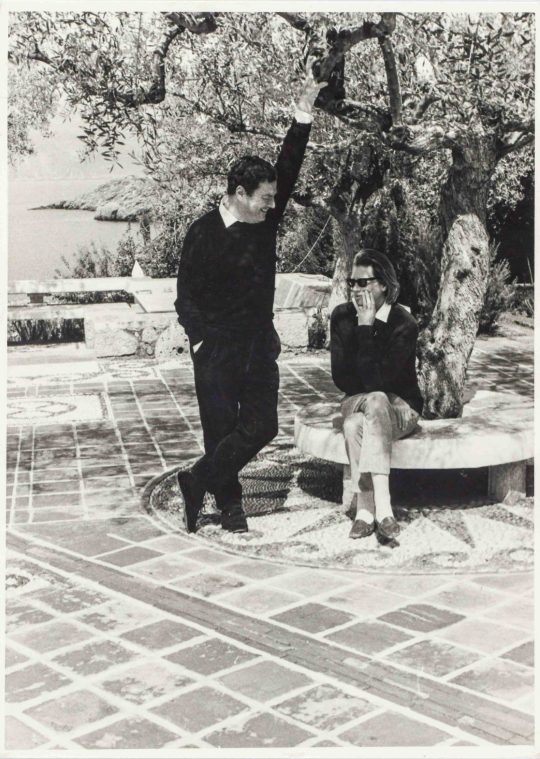
But some of Paddy’s life energy was sucked out of him when Joan died in Kardamyli in June 2003, aged 91. It was related that Joan said to her friend Olivia Stewart, who was visiting: 'I really would like to die but who'd look after Paddy?' Olivia said that she would. A few minutes later, Joan fell, hit her head - and died instantly of a brain haemorrhage. Joan had often quoted Rilke: 'The good marriage is one in which each appoints the other as guardian of his solitude.' Now Paddy Leigh Fermor was all alone.
Leigh Fermor was knighted in 2004, the day of his birthday which he delighted in like a giggling schoolboy. But he missed Joan terribly.
For the last few months of his life Leigh Fermor suffered from a cancerous tumour, and in early June 2011 he underwent a tracheotomy in Greece. As death was close, according to local Greek friends, he expressed a wish to visit England to bid goodbye to his friends, and then return to die in Kardamyli, though it is also stated that he actually wished to die in England and be buried next to his wife, Joan, in Dumbleton, Gloucestershire. He stayed on at Kardamyli until the 9th June 2011, when he left Greece for the last time. He died in England the following day, 10th June 2011, aged 96. It was reported that he had dined in full black tie on the evening of his death. Paddy had style even unto the end.

A Guard of Honour was formed by the Intelligence Corps and a bugler from his former regiment, the Irish Guards, delivered the ‘Last Post’ at Paddy’s funeral. As had been his wish, he was buried beside Joan. On his gravestone in Dumbleton cemetery is an inscription in Greek, a quote from Constantine Cavafy: “In addition, he was that best of all things, Hellenic.”
Although Joan had passed away at the age of ninety-one, after suffering a fall in the Mani. Her body was repatriated to Dumbleton, the place of her birth - ironic that her dream was to be as far as she could possibly go from the rolling humdrum Worcestershire hills. But perhaps she intended to return all along. When Paddy was buried beside her it seemed that the ‘pact of liberty’ that these two lonely souls had forged themselves could be tested in the great elsewhere. Joan was more than his muse (as many of her obituaries were at pains to declare) but his greatest adventure.
To come around full circle from the movie ‘Ill Met By Moonlight’ (1957) that I saw that night in Verbier, my father told me that rather poignantly, General Kreipe, the German commander Leigh Fermor had captured - once an enemy, and later a friend - left behind notes and photographs from across his life. On one of those notes, it was discovered, the following was scribbled from a brief visit to Greece: “Somewhere, amidst all the disarray, was the story of Joan and Paddy, and” it concluded, “…of their lives together.”
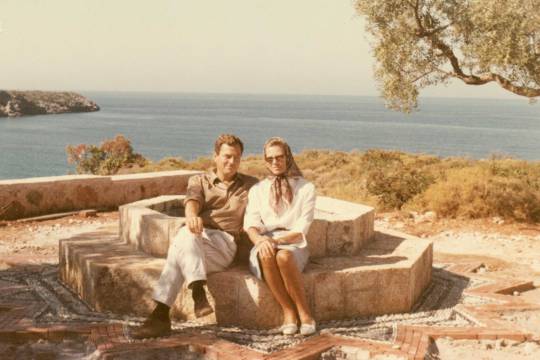
His life with Joan and all that she meant to him was one part of the mosaic of who Paddy Leigh Fermor was. But it’s incomplete.
Paddy didn’t like the idea of a biography, and neither did Joan when she was alive. But friends had persuaded them that unless Paddy appointed someone to write his life, he might find himself the subject of a book whether he liked it or not. In Artemis Cooper they couldn’t have chosen a better writer to chronicle Paddy’s life as a man of action and letters. Cooper, was the daughter of another accomplished diplomat and historian, John Julius Norwich, and grand-daughter of Duff and Diana Cooper. As the wife of the historian Antony Beevor, she became a trusted friend of the Leigh Fermors. Cooper was too good of a historian to let her friendship lead her astray from being a faithful but serious biographer. Knowing this, she was told she could go ahead, but she had to promise not to publish anything until after they were both dead.
Paddy did not like being interviewed, and would keep her questions at bay with a torrent of dazzling conversation. He was the master at deflecting discussions away from himself.
He was also very unwilling to let Cooper see many of his papers, though the refusal always couched in excuses. ‘Oh dear, the Diary…’ It was the only surviving one from his great walk across Europe, and I was aching to read it. ‘Well it’s in constant use, you see, as I plug away at Vol III,’ he would say. Or, ‘My mother’s letters? Ah yes, why not. But it’s too awful, I simply cannot remember where they’ve got to…’ It was quite obvious that he and Joan, while being unfailingly generous, welcoming and hospitable, were determined to reveal as little as possible of their private lives.
While they were more than happy to talk about books, travels, friends, Crete, Greece, the war, anything - they would not tell her any more than they would have told the average journalist. But she persisted and got closer than most. He showed particularly gallantry in not talking about his romantic entanglements. But she soon twigged that anytime he described a woman as ‘an old pal’ it was a sure bet that he had an affair with her.
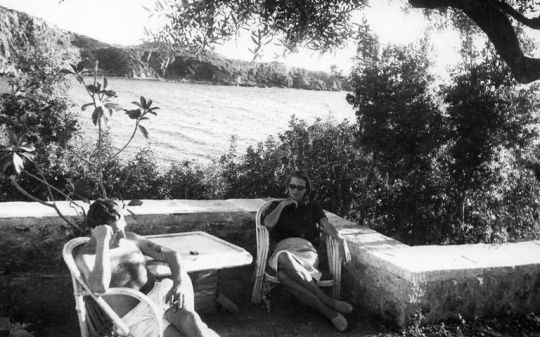
Intriguingly, Paddy liked to claim he was descended from Counts of the Holy Roman Empire, who came to Austria from Sligo. Paddy could recite ‘The Dead at Clomacnoise’ (in translation) and perhaps did so during a handful of flying visits to Ireland in the 1950s and 1960s, partying hard at Luggala House or Lismore Castle, or making friends with Patrick Kavanagh and Sean O’Faolain in Dublin pubs. He once provoked a massive brawl at the Kildare Hunt Ball, and was rescued from a true pounding by Ricki Huston, a beautiful Italian-American dancer, John Huston’s fourth wife and Paddy’s lover not long afterwards.
And yet, a note of caution about Paddy’s Irish roots is sounded by his biographer, Artemis Cooper, who also co-edited ‘The Broken Road’, the final, posthumously published instalment of the trilogy. “I’m not a great believer in his Irish roots,” she said of Leigh Fermor in an interview, “His mother, who was a compulsive fantasist, liked to think that her family was related to the Viscount Taaffes, of Ballymote. Her father was apparently born in County Cork. But she was never what you might call a reliable witness. She was an extraordinary person, though. Imaginative, impulsive, impossible - just the way the Irish are supposed to be, come to think of it. She was also one of those sad women, who grew up at the turn of the last century, who never found an outlet for their talents and energies, nor the right man, come to that. All she had was Paddy, and she didn’t get much of him.”
And I think that’s the point, no one really got much of Paddy Leigh Fermor even as he only gave a crumb of himself to others but still most felt grateful that it was enough to fill one’s belly and still feel overfed by him.
Paddy never tried to get to the bottom of his Irish ancestry, afraid, no doubt, of disturbing the bloom that had grown on history and his past, a recurring trait. “His memory was extraordinary,” Artemis Cooper noted, “but it lay dangerously close to his imagination and it was a very porous border.”
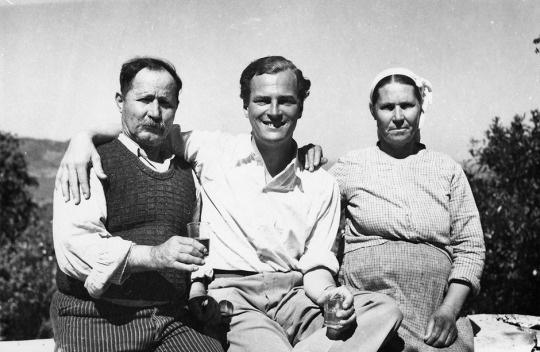
Within the Greek imagination many Greeks saw in Paddy Leigh Fermor as the second coming of Lord Byron. It’s not a bad comparison.
Lord Byron claimed that swimming the Hellespont was his greatest achievement. 174 years or so later, another English writer, Patrick Leigh Fermor - also, like Byron, revered by many Greeks for his part in a war of liberation - repeated the feat. Leigh Fermor, however, was 69 when he did it and continued to do it into his 80s. Byron was a mere 22 years old lad. The Hellespont swim, with its mix of literature, adventure, travel, bravery, eccentricity and romance, is an apt metaphor for Leigh Fermor’s life. Paddy Leigh Fermor was the Byron of his time. Both men had an idealised vision of Greece, were scholars and men of action, could endure harsh conditions, fought for Greek freedom, were recklessly courageous, liked to dress up and displayed a panache that impressed their Greek comrades. Like a good magician it was also a way to misdirect and conceal one’s true self.
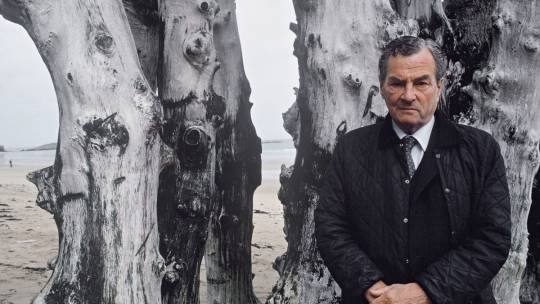
What or who was the true Paddy Leigh Fermor?
Like Byron, Leigh Fermor appeared as a charismatic and assured figure. He was a sightseer, consuming travel, culture, and history for pleasure. He was an aristocrat moving in the social circles of his time. He was a gifted amateur scholar, speculating on literary and historical sources. Leigh Fermor, Byron’s own identity, is subject to textual distortion; it emerges from a piece of occasional prose in his books and is shaped by the claims of correspondence on a peculiarly fluid consciousness.
There is no hard and fast distinction to be drawn here between real and imagined, only a continuity of relative fictions that lie between memory and imagination as his biographer asserted. If there is a will to assert identity here, to disentangle fact and fiction, to give things as they really are and nail down the real Leigh Fermor then it is somewhere between the two. This is where we will find Paddy.
For many his death marked the passing of an extraordinary man: soldier, writer, adventurer, a charmer, a gallant romantic. As a writer he discovered a knack for drawing people out and for stringing history, language, and observation into narrative, and his timing was perfect. Paddy often indulged in florid displays of classical erudition. His learned digressions and serpentine style, his mannered mandarin gestures, even baroque prose, which Lawrence Durrell called truffled and dense with plumage, were influenced by the work of Charles Doughty and T.E. Lawrence. But one can’t compare him. I agree with the acclaimed writer Colin Thurbon who said, “There is, in the end, nobody like him. A famous raconteur and polymath. Generous, life-loving and good-hearted to a fault. Enormously good company, but touched by well-camouflaged insecurities. I would rank him very highly. ‘The finest travel writer of his generation’ is a fair assessment.”
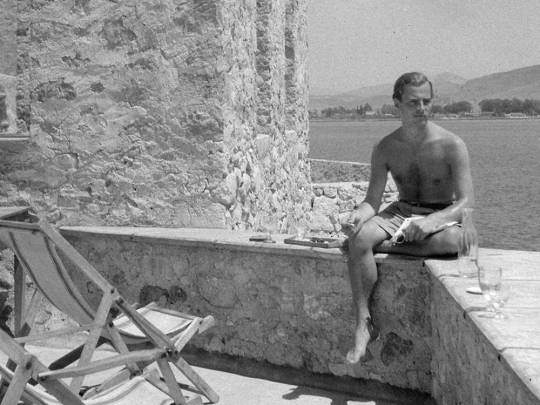
As a child I didn’t really know who Paddy Leigh Fermor was other than this very cheerful and charismatic old man was kind, attentive, and took a boyish delight in everything you were doing. Only later on in adulthood was it clear to that Paddy was not only among the outstanding writers of his time but one of its most remarkable characters, a perfect hybrid of the man of action and the man of letters. Equally comfortable with princes and peasants, in caves or châteaux, he had amassed an enviable rich experience of places and people. “Quite the most enchanting maniac I’ve ever met,” pronounced Lawrence Durrell, and nearly everyone who’d crossed paths with him had, it seemed, come away similarly dazzled.
I am equally dazzled - more smitten in retrospect - for alas they don’t make men like Paddy any more. But every time I dip back into his books I think I discover a little bit more of who Paddy Leigh Fermor was because I find him some where between my memory and my imagination.
#essay#paddy leigh fermor#leigh fermor#joan raynor#joan leigh fermor#greece#crete#second world war#SOE#war#british army#history#general kreipe#stanley moss#literature#author#writer#travel#explorer#wanderlust#travel writing#europe#mani#peloponnese#kardamlyi#lord byron#ill met by moonmight#film#movie#personal
113 notes
·
View notes
Text
youtube
I'll post it here too. My latest video after taking a year off from youtube.
#aishyo#time travelling while black#media analysis#video essay#kindred#doctor who#Timewasters#see you yesterday#Youtube
31 notes
·
View notes
Text
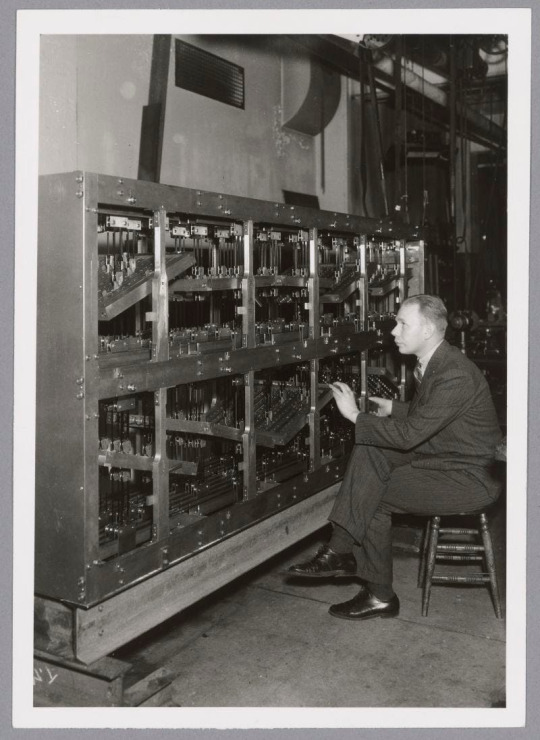
My great grandfather “Bud” Wilbur gave his son Jack an Erector Set one Christmas then took it back the same day. The Erector Set was a children’s toy made of metal pieces that allowed kids to build various model structures like bridges and poorly made bridges. Before video games, children had very few choices for entertainment: marbles, Erector Sets, or becoming a Peeping Tom. Those were the choices. My grandpa Jack was going to be an engineer like his father, and to seal his fate, great grandpa Bud bought him the tools to try his hand at building. Bud, seeing the pieces scattered on the floor must have thought “pearls before swine” while having his eureka moment. Using the toy he had bought his son, he built a model of what he called The Simultaneous Calculator, what the American papers in 1937 called “Robot-Einstein,” and what the Japanese dubbed “The Wilbur Machine.”
He didn’t build the first calculator. I believe that honor technically belongs to the Mesopotamians who made the first abacus. Nor did the calculator conceptually resemble the digital computing systems we have now that employ ones and zeros and a lot of electricity. The Wilbur Machine was an analog computing system with pulleys and brass bars that solved 9 equations simultaneously (or 9x9 systems according to an MIT grad’s thesis that I can only comprehend up to page 4). Math equations that once took a full day to solve now took roughly 1-3 hours. It sped up the production of large structures, power grids, and for one country it seems, planes. It was a big advancement in 1936-37, an advancement that was eclipsed by better smaller machines soon after. In the United States, that is. In Japan, a 3x3 system Wilbur Machine was replicated in the late 30s and a fully functioning 9x9 calculator was completed in 1944 at the Tokyo Imperial University’s Aviation Laboratory.
You read that correctly. My great-grandfather Bud Wilbur built a machine that was stolen by an Axis power right before World War II. Japan continued to use the machine until the war’s end. So, uh…sorry about that? It wasn’t Bud’s intention.
Read the rest of the essay here.
#essays#essay#writing#reading#personal essay#Japan#interesting#travel#science#math#MIT#Wilbur machine#dan wilbur#long reads#movies#family
27 notes
·
View notes